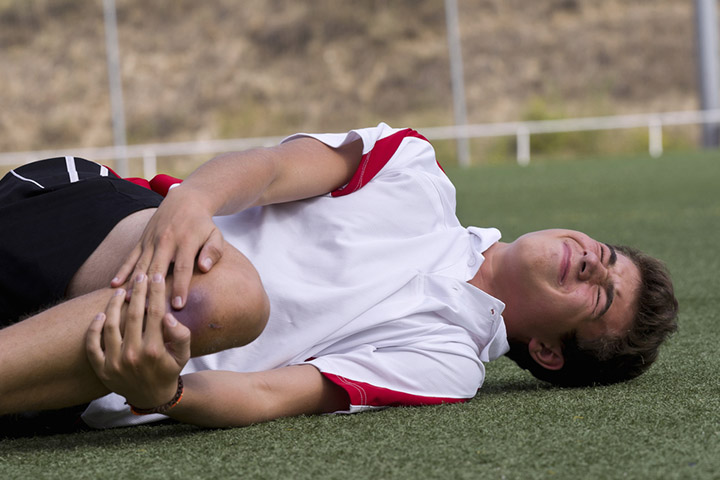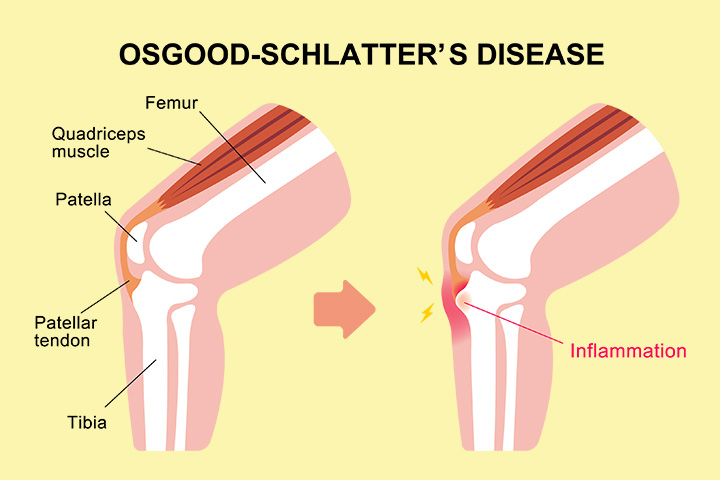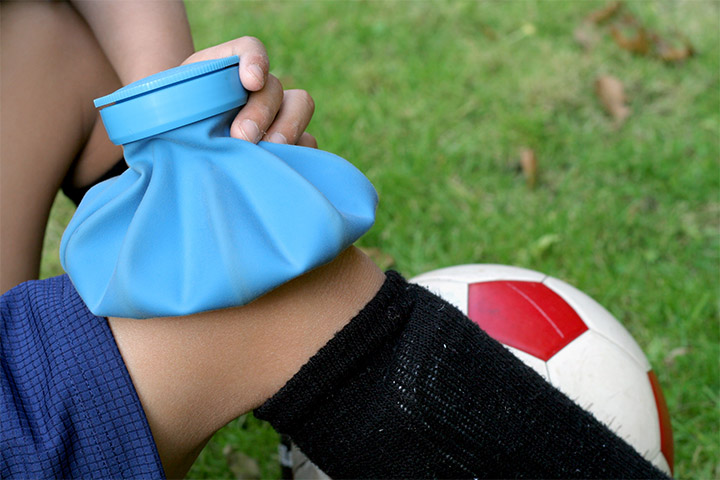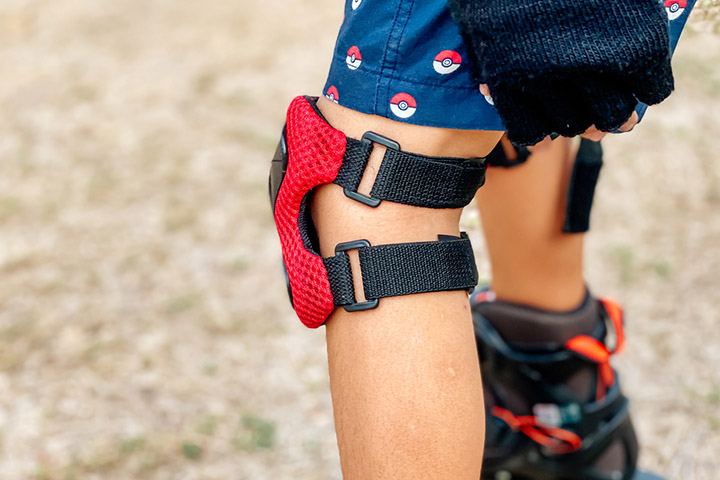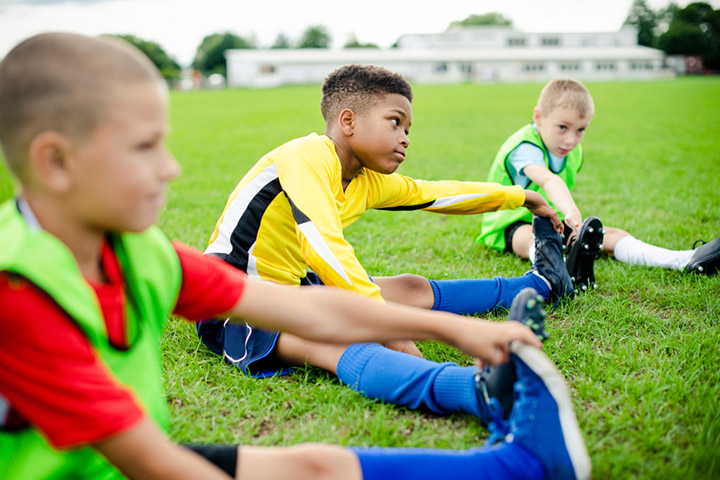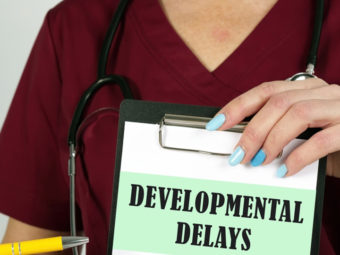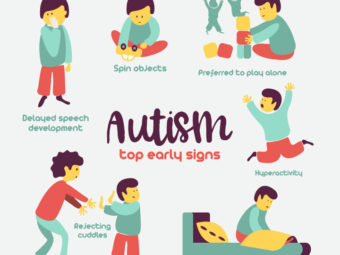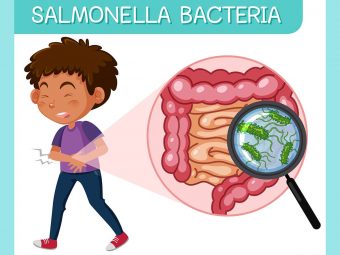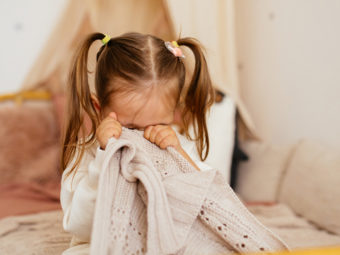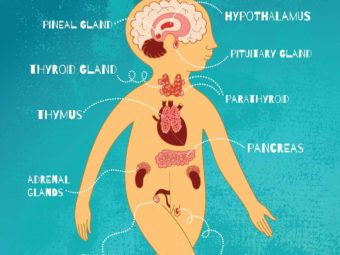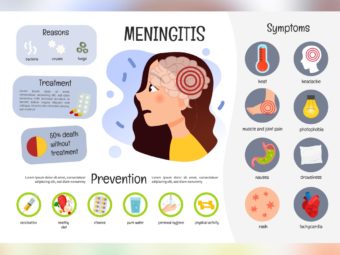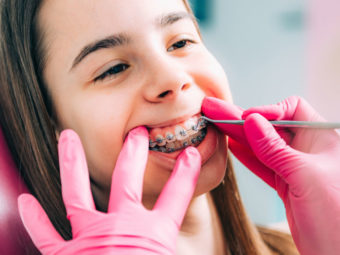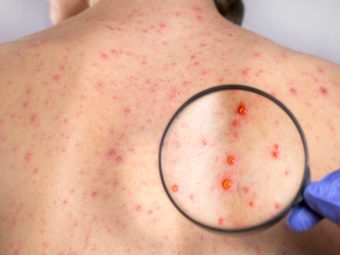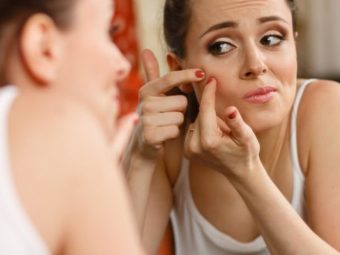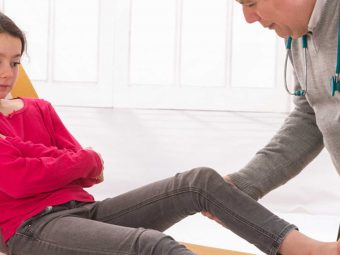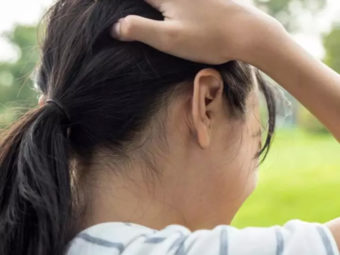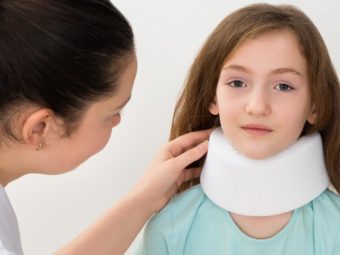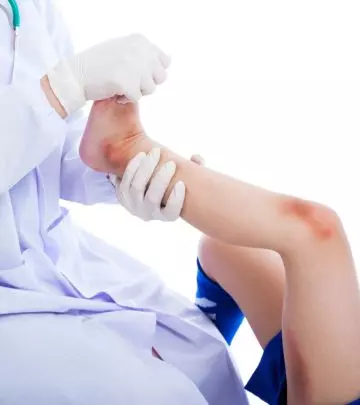
In most cases, knee pain in children can be due to growing pain, and there is no need for medical attention since it may resolve quickly without complications. However, it is always necessary to identify the exact causes of knee pain in children. Dr. Mark Halstead, MD, Sports Medicine Specialist at St. Louis Children’s Hospital, says, “knee pain can result from because of overuse, imbalance in muscle strength and flexibility or from Osgood-Schlatter disease (1).” Knee pain with other symptoms, such as redness and swelling, may require prompt medical care.
Read on to know more about the causes and treatment of knee pain in children and when to see a doctor.
Causes Of Knee Pain In Children
There could be various causes for knee pain in children. Here we list some of them.
Normal Causes For Knee Pain In Children
According to a research article published in the British Medical Journal, Growing pain normally occurs in children between the ages three-twelve, usually during the evening or night. If the pain is felt in both legs, in the front of the thighs or calves or behind the knees, without any external swelling or injury, then it might be growing pain. These pains are not usually associated with limping and may not have any signs of local trauma and infection (2).
Growing pains usually don’t require any medical intervention, and they tend to fade away after a certain age. If you are unsure that the knee pain is a growing pain, then it is best to consult your pediatrician (3). Also, the use of aspirin as a pain reliever is not recommended for children below the age of 16 years, as it can cause Reye’s Syndrome (4).
Causes For Knee Pain In Children Which Could Raise A Concern
Apart from these, here are a few causes of knee pain, which could be an indication of an underlying condition. Some children can have congenital deformities that cause knee pain. Additionally, the below causes include both an underlying medical condition as well as the wear and tear of the knee when a child is active in sports.
1. Knee injuries:
Image: Shutterstock
Your child can also have knee pain because of different types of injuries, such as growth plate injuries or knee fractures. If your child’s knee shows the below symptoms, then it is best to seek professional advice.
- If the knee is not able to support the weight of the body
- The kneecap feels out of place, and cannot have a full-motion
- There is a painful popping or crackling sound
- There is swelling, and the knee is locking (5)
2. Infection in the knee
Bacterial bone infections in the knee may result in conditions such as osteomyelitisi and septic arthritis.
In neonates and infants, the symptoms are nonspecific, which may include irritability, refusal to walk, or limited spontaneous movements of limbs.
Whereas in older children, symptoms such as swollen and painful joints are associated with effusion, functional impairment, tenderness, and local warmth (6).
3. Juvenile arthritis
IIf the child shows signs such as pain, inflammation, stiffness of joints, and fatigue, it could indicate the onset of an autoimmune disease known as juvenile arthritis. The most common type of arthritis in children is juvenile idiopathiciXA disease that occurs spontaneously with no identifiable cause or origin. arthritis (7). According to the American College of Rheumatology, one in every 1,000 children is diagnosed with Juvenile idiopathic arthritis (JIA). Usually, multiple joints, such as knee, ankle, elbow, wrist, and finger joints, are involved in juvenile arthritis.
4. Osgood-Schlatter disease
Image: Shutterstock
Osgood-Schlatter disease is an inflammation of the region where the shinbone attaches to the kneecap, causing knee pain in adolescents. This usually occurs during puberty, when the child goes through growth spurts. It could be common in children who actively participate in athletics and sports (8).
5. Jumper’s knee
Jumper’s knee is a painful knee condition, where accumulated stress on the patellar tendoniXAttaches the bone in front of the knee to the one in the lower leg and permits knee extension for different activities. causes tears in the region.
This mainly occurs in children who are involved in jumping sports. The common symptoms of this include pain due to prolonged sitting, squatting, and stair climbing. Also, sudden tendon pain occurs when there is a loading impact on the knee and stops immediately when the load is removed. It is rarely experienced while resting (9).
6. Soft tissue knee injuries
A soft tissue injury is a ligament injury or the damage of tendons and muscles in a body region. Soft tissue knee injury refers to the trauma caused due to excessive pressure or overuse of the ligaments, tendons, and muscles (10).
7. Patellofemoral syndrome (PFS)
Patellofemoral pain syndrome is a pain in the anterior part of the knee. This is a common condition among teenagers and athletes. Overuse injuries, displaced kneecap, or excess weight or pressure applied on the kneecap result in roughening, softening, or wearing down of the cartilage below the kneecap (11).
Kids with Patellofemoral syndrome experience pain when they squat, jump or bend the knee.
8. Quadricep’s tendinitis
Teenagers who play sports such as soccer and football, which involve a lot of running, tend to overuse their knee structures, resulting in strain or injury of the quadriceps muscle. This leads to pain, swelling, and weakness in the knee. Pain is usually felt in the lower thigh region, above the patella, when the person tries to move the knee (12).
9. Bone tumors
Osteosarcoma is a bone tumor that is usually found in adolescents and young adults and develops at the edges of long bones that form the knee. It has symptoms such as pain in the bone, stiffness, swelling, or tenderness in the bone, weak bones, fatigue, weight loss, and anemia.
Besides these, bursitis (inflammation of the bursae) and blount’s disease (growth disorder affecting the lower leg bones) are some other conditions that can cause knee pain in children.
The doctor will then diagnose the condition and prescribe multi-agent chemotherapy or surgical management (13).
10. Meniscal tears
Meniscal tears occur in the knee’s shock-absorbing cartilage, the meniscus, located between the shinbone (tibia) and thighbone (femur). The meniscus helps distribute weight, enables smooth knee bending, and facilitates lubricating fluid movement in the joint. They’re common in active children or teenagers who twist their knees during sports involving pivoting or sudden movements. These tears cause pain and, if untreated, can increase the risk of arthritis development. Any child is susceptible to this injury, but it often happens due to sudden knee twists during athletic activities (14).
When To See A Doctor?
Growing pains usually don’t require any medical intervention, as they tend to fade away after a certain age.
But it is time to call a pediatric orthopedics expert if the pain lasts for over two weeks and the child has:
- Pain for a long duration, sometimes throughout the day
- Joint pains
- Pain in the mornings
- Weakness in the knees and is limping
- Fever
- Swollen, red, or tender joints
 Quick fact
Quick factIn general, if the pain is affecting the child’s performance, a doctor’s evaluation is imperative.
Diagnosis Of Knee Pain
The doctor may ask you questions about the nature of the pain, its longevity, and when the child experiences it the most.
The doctor may inquire about other visible symptoms such as fever and rashes that can indicate juvenile rheumatoid arthritis (more commonly known as juvenile idiopathic arthritis). Post physical examination, X-rays, MRI, CT Scan, or blood work may also be recommended.
 Point to consider
Point to considerTreating Knee Pain In Children
The treatment of knee pain in children depends on the cause. The standard treatment methods of knee pain are explained below.
1. RICE
Image: IStock
Sometimes, all your child needs is a little rest to get relief from knee pain. According to Michigan Medicine, RICE – Rest, Ice, Compression, and Elevation could help in relieving knee pain. This method is recommended immediately after an injury, sprains, and strains (15).
However, it is best to have a clear diagnosis of the knee pain to know the root cause, as these methods only help in treating the pain and not the underlying cause.
- Rest: If the pain is due to a strained muscle or ligament, resting the knee may help in minimizing the sprain and reduce the pain. Place a small pillow under the knee when resting for relief.
- Ice packs: If there is a swelling along with pain, it is believed that ice might help. Apply an ice pack immediately after the injury to minimize the chances of swelling. Avoid hot water, hot showers, or hot tubs that can aggravate swelling, for at least 48 hours after the injury.
- Compression: The swelling of the knee might be decreased by wrapping it tightly (not too tightly though) with an elastic bandage. However, it is advised to consult your child’s doctor, as compression may not be recommended if there is an injury or sprain.
- Elevate: Swelling could be minimized by stretching the swollen knee in an elevated position. When sitting, use soft pillows to prop up the knee above the heart’s level. When sleeping, just place one pillow to elevate the knee slightly.
- Massage: If there is no swelling, pain in the knee could be alleviated with a gentle massage.
This might work if the knee pain is because of normal sprain, but if there is an underlying cause, then these remedies might not be able to relieve the pain. If the pain and swelling do not come down even after trying these tips for a day, then it is best to schedule an appointment with your child’s doctor.
2. Physical therapy and exercises
Therefore, exercising the knee can help relieve and reduce the chances of its recurrence (16). Help your child in doing Hamstring, Quadriceps stretches and knee to chest, straight leg raises, and wall side with pillow or ball exercises.
These exercises are helpful when you do them properly. It is best to consult a physiotherapist before you get the child to try them.
3. Non-steroidal anti-inflammatory drugs
Medication is not usually prescribed for knee pain unless it is due to inflammation, and OTC medications such as ibuprofen can be used to reduce the pain. However, make sure you check with the doctor before giving them to the child.
4. Knee braces
Image: Shutterstock
Knee braces are often recommended for young athletes in training. There are different types of knee support braces for different uses (17).
As a reminder, do not use medication or knee braces for a child’s knee pain without consulting a doctor first.
5. Other treatments
Few herbal remedies may also ease knee pain in children.
- Oral consumption of highly purified Ginger extract could help reduce pain caused due to arthritis. However, it works well when taken alongside any prescription medications for arthritis, as the effect of ginger alone was found to be moderate (18).
- Apple cider vinegar has alkalizing propertiesiXCharacteristic of a substance to neutralize an acid. that can alleviate knee pain. It is believed that adding apple cider vinegar to your child’s bathwater and drowning the knee for 20-25 minutes can help relieve pain. It can also be mixed with coconut oil and massaged on the knee.
- Mustard oil has been used in Ayurveda medicine for long, and is believed that the selenium present in the oil reduces the joint pains (19). Massaging the knees with mustard oil might reduce inflammation, improve blood circulation, in that part of the body and alleviate pain.
It is also believed that lemon (topically), turmeric (taken orally), and eucalyptus oil (topically) are other herbal ingredients that can be used to relieve or alleviate knee pain in children. These remedies work best when they are used to supplement the medical treatment prescribed by the doctor or the physical therapist.
Preventing Knee Pain
Unless your child is diagnosed with an autoimmune disease, normal knee pains can be treated with regular exercise. But with a few tips, you can teach your child to take care of their knees while engaging in sports and other physical activities.
These tips may help in reducing the risk of developing knee pain at a young age.
Other ways to prevent knee pain in children are:
- Losing weight if the child is overweight
- Doing warm-up exercises in the beginning and relaxing exercises at the end of a workout
Image: Shutterstock
- Regular exercise to strengthen the knee muscles and bones to reduce the chances of knee injury or damage
- Bending the knees during landing while jumping
- Training throughout the year to stay fit and reduce the likelihood of injury, especially if the teenager plays a sport such as soccer or football
- Using the right type of running or sport shoes
- Avoiding running down hills or steep terrains that require the child to put extra pressure on the knees.
Frequently Asked Questions
1. When does growing pain stop in children?
Growing pain in children generally stops by the time they are teenagers (20).
2. Can dehydration cause knee pain in children?
Yes. Since 70-80% of joint cartilage is water that has a lubricating effect, dehydration may cause knee pain (21).
3. How does obesity contribute to knee pain in children?
Obesity can cause vitamin deficiencies, hormonal imbalances, and increased stress, affecting bone growth and overall musculoskeletal health. Additionally, it can damage the growth plate, the area of developing cartilage tissue at the end of the leg or arms, which can cause knee deformity and pain (23).
4. Can wearing the wrong shoes lead to knee pain in children?
Wearing the wrong shoes can cause improper distribution of force on the feet. It also leads to inadequate arch support or cushioning, placing additional stress on the knees. Furthermore, such shoes lack adequate shock absorption properties that can transmit more impact force to the knees during running or jumping. The repetitive stress from insufficient shock absorption can lead to knee pain (24).
5. How can knee pain affect children’s daily activities?
Knee pain may cause difficulty in walking, running, or jumping, making the child relinquish certain sports and activities until they recover. Sometimes, the pain might warrant the child to rest more than usual, which reduces their playtime. In addition, it can cause issues in carrying out usual tasks, leading to decreased independence. Furthermore, intense knee pain can cause sleep disruptions, making the child anxious, irritable, and frustrated.
6. Are there any dietary changes that can help prevent knee pain in children?
Diet can’t directly help prevent knee pain in children. However, eating a well-balanced diet can help maintain musculoskeletal health and reduce the risk of conditions that cause knee pain. You can give your teen foods like cruciferous vegetables, fish oil, and herbs like turmeric and ginger that are rich in antioxidants that fight free-radical damage and inflammation associated with certain knee conditions (25).
Knee pain in children is generally a growing pain that does not require medical intervention. However, it is important to check with a doctor to know the reason for the condition because knee pains may also be due to injuries, bacterial infections, or juvenile arthritis. Get the condition medically reviewed if your child experiences joint pains, fever, or knee weakness. Most children get better with rest, ice packs, and massage. Other treatment options may include physical therapy, medications, and knee braces. Encourage your children to maintain an optimum weight, use the right shoes, and do warm-up exercises before a workout to prevent knee pain.
Infographic: How To Help A Child With Anterior Knee Pain?
Anterior knee pain due to knee cap problems can affect a child’s mobility and physical activity level. It can be especially difficult for a child if they usually are physically active. The following infographic suggests some non-surgical interventions parents may consider for a child with anterior knee pain.

Illustration: Momjunction Design Team
Key Pointers
- Knee pain in children can be caused by injuries, infection, juvenile arthritis, Osgood-Schlatter disease, tumors, and other factors.
- Consult a doctor if knee pain lasts more than two weeks, or if the child experiences weakness in the knee causing them to limp, fever, or swollen joints.
- The standard treatment for knee pain includes RICE (Rest, Ice, Compression, and Elevation), physical therapy, medication, and a knee brace.
- Prevent knee pain by maintaining a healthy weight, exercising regularly, using proper footwear, and avoiding putting extra pressure on the knee.
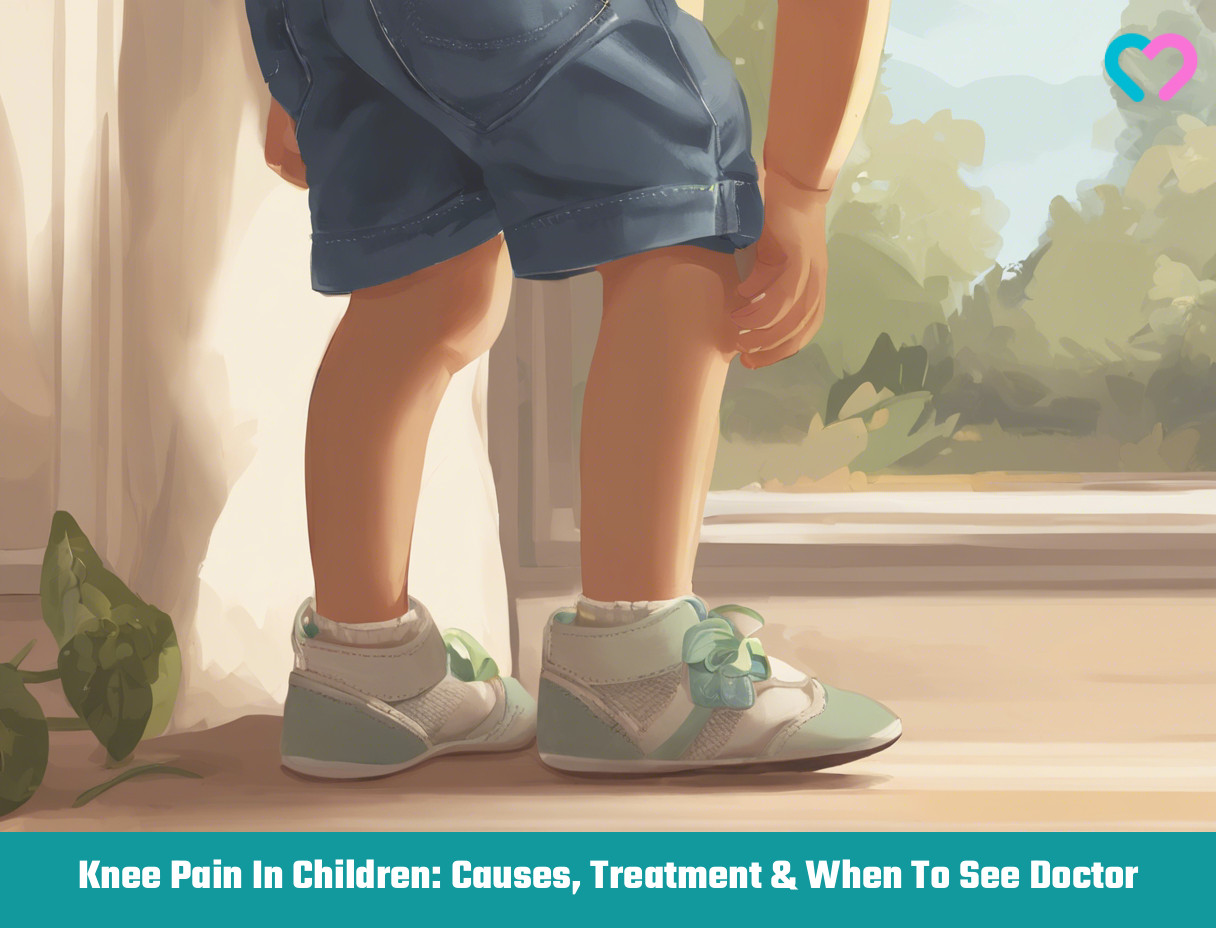
Image: Stable Diffusion/MomJunction Design Team
Knee discomfort can be a painful situation for any child. Discern the roots behind knee discomfort in children, and uncover viable remedies in this video to alleviate and treat the condition.
References
1. Knee pain in kids; St. Louis Hospital
2. Felicity Goodyear-Smith; Growing pains-Parents and children need reassuring about this self-limiting condition of unknown cause; NCBI(2006)
3. How to tell if it’s growing pains – or something more; Akron Children’s Hospital
4. Jennifer Chapman; Justin K. Arnold; Reye Syndrome; NCBI
5. 8 Signs Your Child’s Knee Needs To Be Examined; Nationwide Children’s
6. A. Gigante, et al.; Acute osteomyelitis and septic arthritis in children: a systematic review of systematic reviews; European Review for Medical and Pharmacological Sciences
7. Juvenile Arthritis; National Institute of Arthritis and Musculoskeletal and Skin Disease
8. Raju Vaishya, Ahmad Tariq Azizi, Amit Kumar Agarwal, and Vipul Vijay; Apophysitis of the Tibial Tuberosity (Osgood-Schlatter Disease): A Review; NCBI(2016)
9. Javier A. Santana; Andrew l. Sherman; Jumpers Knee; NCBI
10. Soft tissue injuries; Sports Medicine Australia
11. Wolf Petersen; Patellofemoral pain syndrome; NCBI(2014)
12. Dominic King; Quadriceps tendinopathy: a review—part 1: epidemiology and diagnosis; NCBI(2019)
13. Osteosarcoma; American Childhood Cancer Organization
14. Meniscal Tears; Seattle Children’s
15. Rest, Ice, Compression, and Elevation (RICE); Michigan Medicine; University of Michigan
16. Exercise for stronger knees and hips; Harvard Health Publishing
17. Knee Pain: How to Choose the Right Knee Brace for Your Child; Healthychildren.org
18. Altman RD, Marcussen KC; Effects of a ginger extract on knee pain in patients with osteoarthritis; NCBI(2001)
19. To Study the Beneficial Effect of Mustard Oil and Salt Massaging With Oral Prophylaxis in Patients With Gum Diseases; Clinical trials; US National Library of Medicine
20. Growing Pains; Cleveland Clinic
21. Dehydration and Joint Pain: How Your Hydration is Affecting Joint Health; Orthopedic Associates
22. Anterior Knee Pain in Children and Teens; The Children’s Hospital of Philadelphia
23. The impact of childhood obesity on bone, joint and muscle health; American Academy of orthopedic surgeons
24. Can your shoes cause knee pain; ACE Physical Therapy and Sports Medicine Institute
25. The best foods to help relieve your joint pain; Cleveland Clinic





